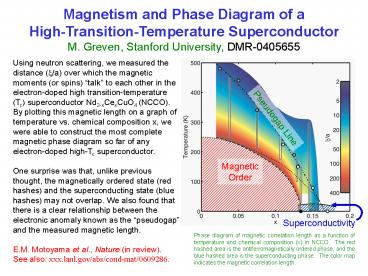Magnetism and Phase Diagram of a HighTransitionTemperature Superconductor M' Greven, Stanford Univer - PowerPoint PPT Presentation
1 / 2
Title:
Magnetism and Phase Diagram of a HighTransitionTemperature Superconductor M' Greven, Stanford Univer
Description:
Phase diagram of magnetic correlation length as a function of temperature and ... clear relationship between the electronic anomaly known as the 'pseudogap' and ... – PowerPoint PPT presentation
Number of Views:108
Avg rating:3.0/5.0
Title: Magnetism and Phase Diagram of a HighTransitionTemperature Superconductor M' Greven, Stanford Univer
1
Magnetism and Phase Diagram of a
High-Transition-Temperature SuperconductorM.
Greven, Stanford University, DMR-0405655
Using neutron scattering, we measured the
distance (?/a) over which the magnetic moments
(or spins) talk to each other in the
electron-doped high transition-temperature (Tc)
superconductor Nd2-xCexCuO4 (NCCO). By plotting
this magnetic length on a graph of temperature
vs. chemical composition x, we were able to
construct the most complete magnetic phase
diagram so far of any electron-doped high-Tc
superconductor. One surprise was that, unlike
previous thought, the magnetically ordered state
(red hashes) and the superconducting state (blue
hashes) may not overlap. We also found that there
is a clear relationship between the electronic
anomaly known as the pseudogap and the measured
magnetic length. E.M. Motoyama et al., Nature
(in review). See also xxx.lanl.gov/abs/cond-mat/0
609286.
Pseudogap Line
Magnetic Order
Superconductivity
Phase diagram of magnetic correlation length as a
function of temperature and chemical composition
(x) in NCCO. The red hashed area is the
antiferromagnetically ordered phase, and the blue
hashed area is the superconducting phase. The
color map indicates the magnetic correlation
length.
2
Magnetism and Phase Diagram of a
High-Transition-Temperature SuperconductorM.
Greven, Stanford University, DMR-0405655
Impact This research has led to significant new
insights into the relationship between magnetism
and superconductivity in a well-known complex
oxide material. This success was enabled by
advanced crystal growth methods and by the use of
neutron scattering techniques. It lays the
foundation for future experimental work involving
the Spallation Neutron Source, and it allows
tests of non-trivial theoretical ideas. Quite
generally, a deeper understanding of complex
oxide materials will likely have a significant
positive future impact on technology.
Education This research comprises a significant
portion of the graduate thesis work by Eugene
Motoyama, who holds an NSF Graduate Fellowship.
One other graduate student (Guichuan Yu) and an
undergraduate student (Inna Vishik) also
benefited from the NSF grant. Inna Vishik was on
of this years APS Apker Award finalists in honor
of her significant undergraduate research. She
also won NSF and Stanford Graduate Fellowships.
Crystal growth of NCCO in an image furnace at
Stanford University.






























